This Famous Piazza Is Known for Its Ristorante Arte and Evening Activities
22 Top-Rated Tourist Attractions in Florence, Italy
We may earn a commission from affiliate links ()
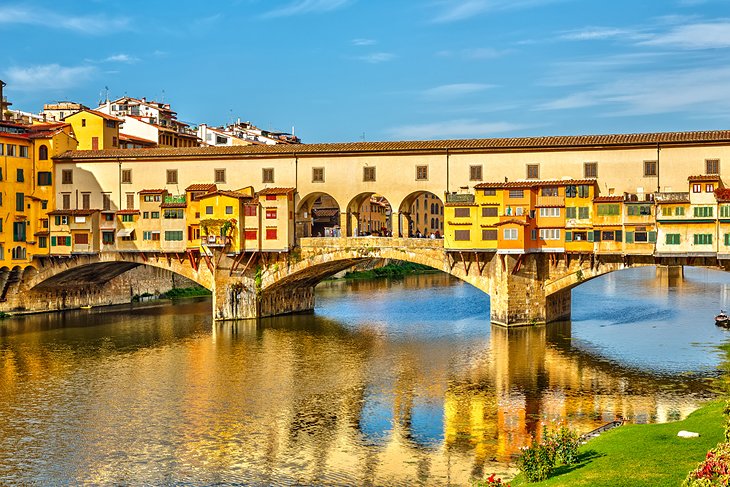
It would accept weeks to see everything Florence has to offering. Virtually any one of its dozens of churches would be the prize tourist attraction of a smaller city. Some of its sights are among Italian republic's all-time-known icons — Ponte Vecchio, Michelangelo'southward David, Brunelleschi'due south Dome — and the unabridged city is a showcase of the Italian Renaissance, the humanist creative movement that broke Europe out of the Night Ages.
But fifty-fifty among such an illustrious drove of palaces, churches, museums, and landmarks, some stand head and shoulders in a higher place the residual. As you consider all the things to see and do in Florence and plan your days of sightseeing, you won't want to miss the highlights that take made Florence 1 of Europe's most popular cities.
You lot'll be certain to detect the all-time places to visit by using this handy list of the tiptop attractions and things to practise in Florence.
See also: Where to Stay in Florence
Note: Some businesses may be temporarily closed due to contempo global wellness and safety issues.
1. Cathedral of Santa Maria del Fiore and Piazza Duomo
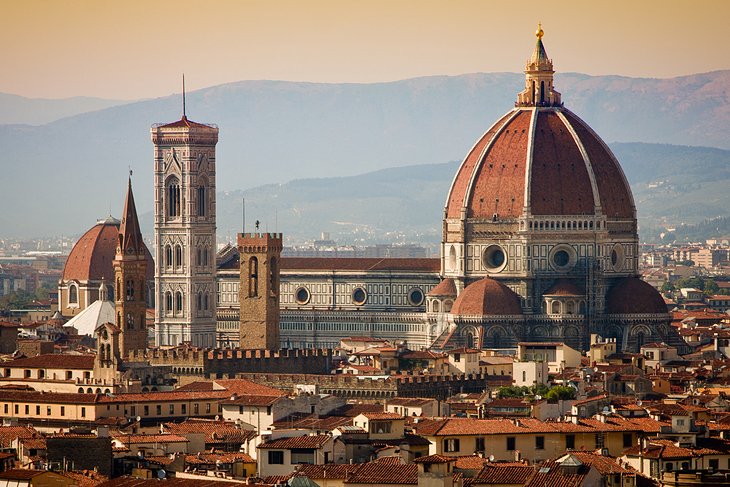
Piazza Duomo and the grouping of buildings that form its cathedral circuitous gather some of Italy's greatest creative treasures into ane relatively small area. As yous tour the baptistery, the bong belfry, the cathedral, and its museum, yous'll see some of the all-time-known masterpieces of art and architecture past the greatest artists of the Italian Renaissance -- Ghiberti, Brunelleschi, Donatello, Giotto, and Michelangelo.
Begin by walking around the square to admire the intricate inlaid marble exteriors, so step inside each i to look more than closely at the stained-glass works of art that greet you wherever you look.
If waiting in long lines to purchase a ticket is not your idea of fun - especially on a hot day - consider the Skip the Line: Florence Duomo with Brunelleschi'southward Dome Climb bout. This two.five-hour guided tour includes the cathedral, the dome, the baptistery, entrance fees, and the option to visit the Opera del Duomo Museum on your ain.
- Read More than: Exploring Santa Maria del Fiore Cathedral: A Visitor'southward Guide
two. Battistero di San Giovanni (Baptistery of St. John)
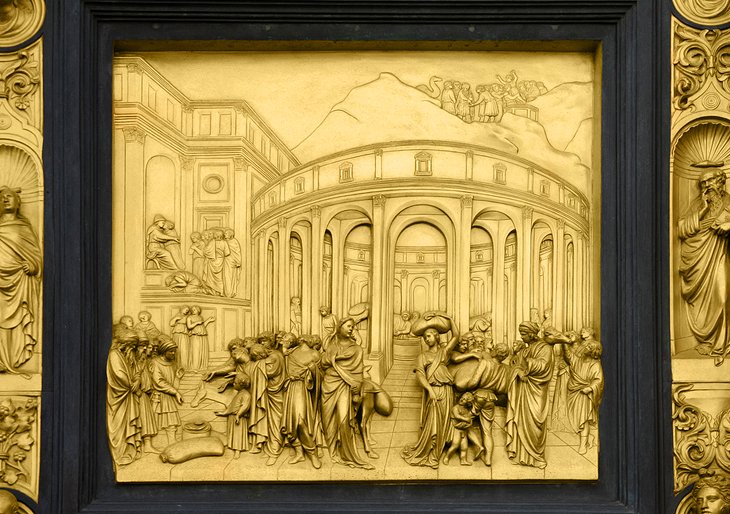
From any angle, within or out, the 12th-century octagonal baptistery is a consummate work of art. Its marble façade, the intricate mosaics of its interior, and the art works information technology holds all merit a place high on your list.
But the magnificent bronze panels that Ghiberti created for the doors facing the cathedral trump them all. Nowhere has bronze been worked with such exquisite expression as in these Gates of Paradise. For a closer look, and to see some of the treasures that accept been made for the baptistery, visit the Museo dell'Opera del Duomo, the cathedral's museum.
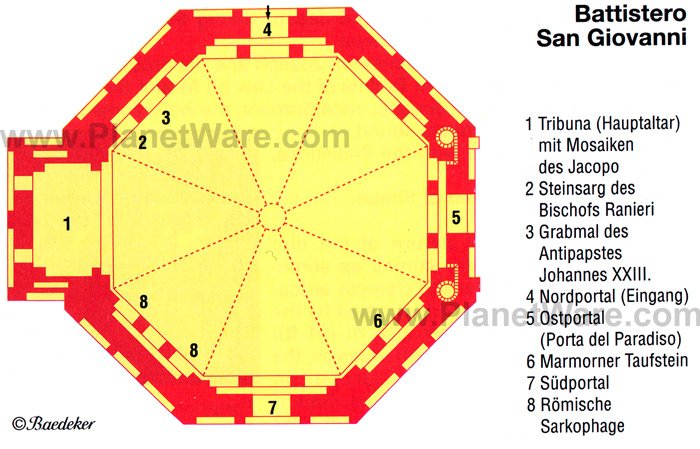
3. Meet Florence from Piazzale Michelangiolo
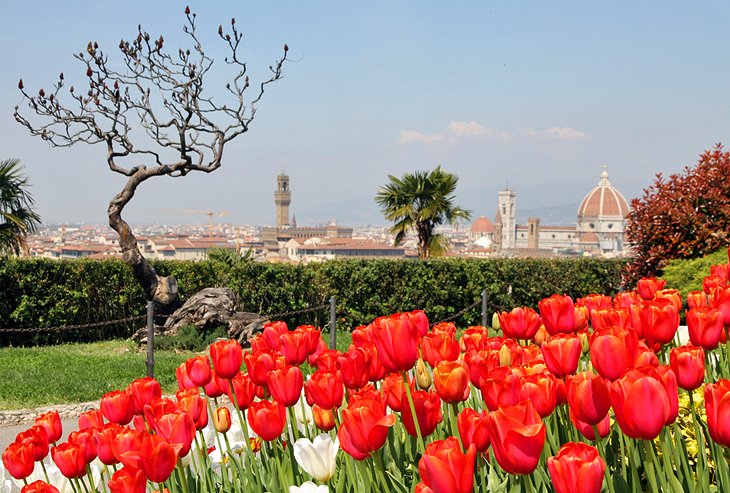
And then often misspelled equally Piazzale Michelangelo that even city tourism material occasionally slips up, this terrace above the metropolis is an obligatory stop for tour buses, and the spot from which all those postcard shots of the cathedral are taken. During busy tourist seasons, the best fourth dimension to enjoy information technology in relative peace is late afternoon or early on evening; it's especially lovely at sunset.
Although you can become a 360-caste panorama of Florence from the dome of the cathedral, only from this terrace tin can you fully capeesh how Brunelleschi'southward dome dominates the city eye. Nor tin any other elevation give you this sweeping city view that encompasses the Ponte Vecchio, Palazzo Vecchio, Santa Croce, and other landmarks.
You can walk here, climbing from the riverbank through the gardens, or take bus 12 or 13. While you're here, go along up to the church of San Miniato al Monte or stay on the bus to the church and walk dorsum down.
4. Uffizi Palace and Gallery
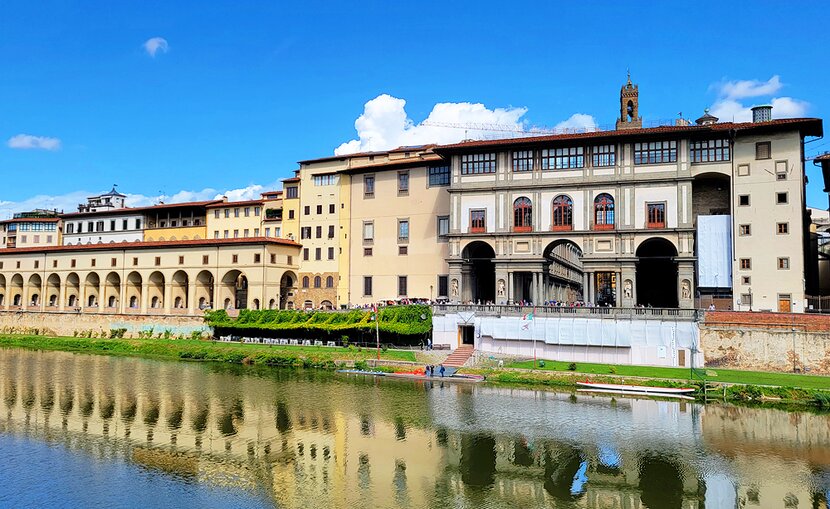
Few would contend the Uffizi'due south place among the handful of world's pinnacle art museums. Its collections are simply staggering in their diverseness and quality, and even if art is not your chief involvement, you should encounter the highlights of the paintings here.
You lot'll come abroad understanding a lot more of how Florence'southward 14th- to 16th-century painters changed the face of western art, as y'all run across the transition from the stilted Byzantine images to the life-like figures and landscapes of the Renaissance artists.
The vast building stretching along the river was i more of the Medici palaces but was intended not as a residence, only to house governmental offices, scientific studies, and part of their growing art drove. 1 of its loveliest spaces, the octagonal Tribuna, was commissioned especially to display the most prized paintings and jewels of Francesco I de' Medici.
Yous can bypass the long expect for admission and get directly to the entrance with a Skip the Line: Florence Accademia and Uffizi Gallery Tour that gives you priority access likewise as a guided bout.
- Read More:
- Visiting the Uffizi Gallery in Florence: 12 Elevation Highlights, Tips & Tours
5. Piazza della Signoria and the Loggia dei Lanzi
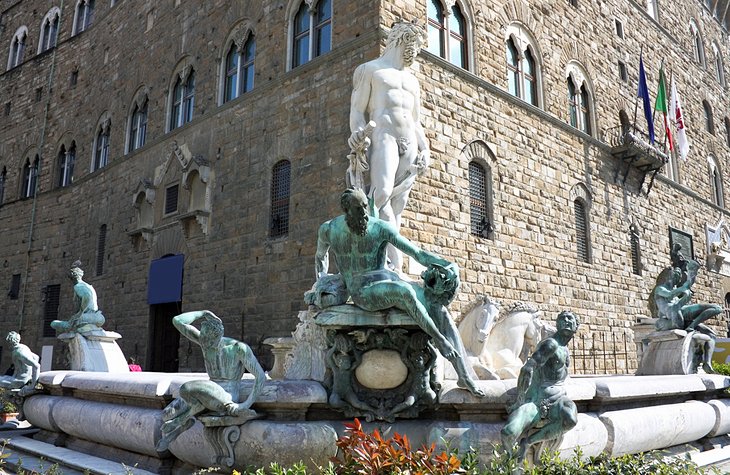
This wide foursquare has been the centre of power in Florence since its 14th-century origins - and perhaps even before, equally Etruscan and Roman remains have been constitute below its pavement. Today, information technology is the social center likewise, a favorite meeting place filled with tourists and locals. At its centre is the Neptune Fountain, at one side the Palazzo Vecchio, still housing the city's government.
Against the wall of the Uffizi, which forms ane end of the piazza, is the Loggia dei Lanzi, an outdoor sculpture gallery with several notable pieces. Nearly widely recognized of these is Benvenuto Cellini's best-known piece of work, Perseus with the Head of Medusa. In forepart of the Palazzo Vecchio is a copy of Michelangelo's David.
- Read More: Exploring Piazza della Signoria in Florence: A Visitor's Guide
6. Galleria dell'Accademia (Academy Gallery)
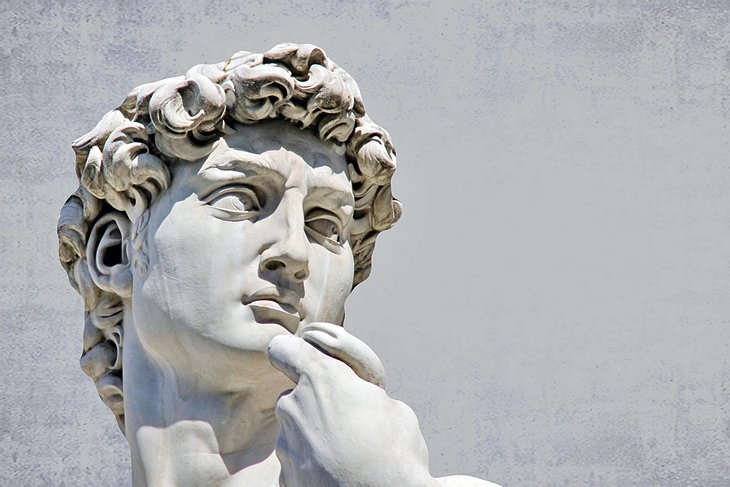
Michelangelo's best-known work, David, is copied all over Florence, but inside this art museum, you'll find the original. Unfortunately, as a result of an attack on the sculpture, it is now behind glass, simply it nonetheless never fails to inspire.
The David isn't the only Michelangelo here, nor is information technology the simply important masterpiece. In the sculptures shown in the same gallery, y'all can near watch Michelangelo at work as yous see the iv unfinished slaves, meant for a tomb in Rome, seemingly in the process of beingness released from the marble.
Here, also, is his St. Matthew for Florence cathedral, also unfinished. You lot'll desire to look in the other galleries to see highlights past 13th- to 16th-century Florentine artists, especially if yous practice not program to meet the Uffizi Gallery collections. Sandro Botticelli'southward Madonna is a highlight.
You tin can save time waiting in the long lines at both these outstanding art museums with a Skip the Line: Florence Accademia and Uffizi Gallery Tour that takes you direct to the entrance, as well as a guided tour.
vii. San Lorenzo and Michelangelo's Medici Tombs
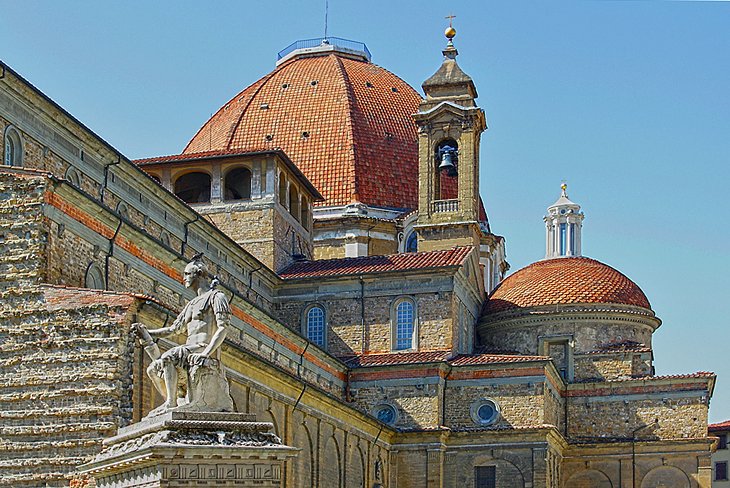
The Medici commissioned the best talent for the family church and burial chapels: Brunelleschi for the church and Michelangelo for the chapel intended to memorialize their most illustrious princes. Both artists died earlier finishing the piece of work, but Brunelleschi's church building was completed according to his plans.
Michelangelo's chapel, called the New Sacristy, was not; in fact, it was never completed at all. But what he did cease is considered ane of the world's crowning achievements in marble sculpture. Equally you tour the church, the Old Sacristy, the New Sacristy, the Princes' Chapel and the Laurenziana Library, you lot'll find the works of other Renaissance masters, including Donatello and Lippi.
- Read More than: Exploring San Lorenzo in Florence: A Visitor's Guide
viii. Palazzo Vecchio (Palazzo della Signoria)
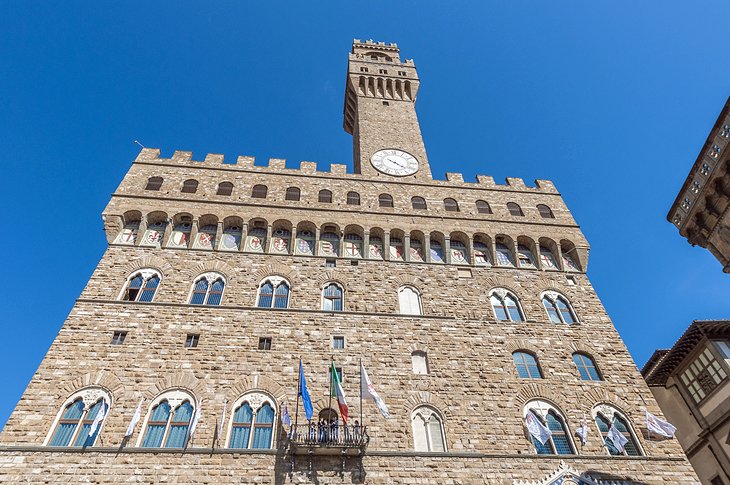
History, art, and ability repeat in the opulent rooms and k galleries of this fortress-like palace in the eye of Florence. From hither, the city/republic was ruled, and its powerful Medici family commissioned the leading artists and architects of the day to design and decorate their offices and apartments.
Be sure to sign up early for one of the complimentary tours, so y'all'll get to run into some of the secret passages the Medici used to move among the rooms; return in the evening (salve your ticket) to climb to the roof for sunset views of the city.
- Read More: Exploring Palazzo Vecchio (Palazzo della Signoria) in Florence: A Visitor's Guide
nine. Santa Croce
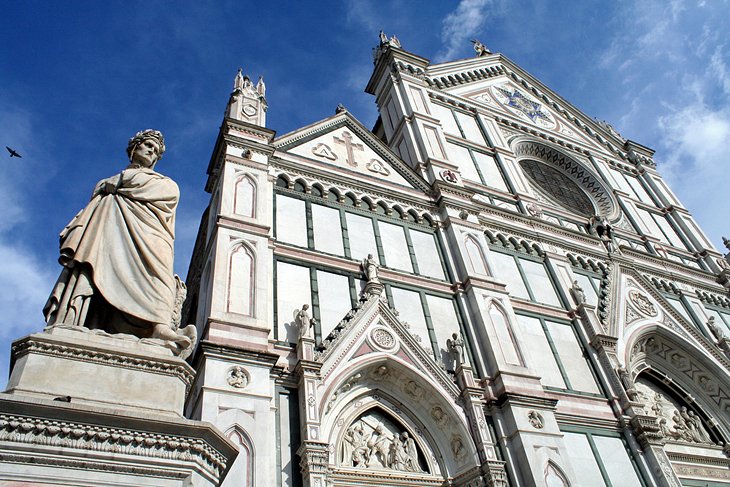
Backside the geometric marble inlay of its typical Tuscan façade, Santa Croce is both art-filled church and mausoleum for some of Florence's greatest names. Amid its treasures are several landmarks of Renaissance art.
You volition want to look especially for Cappella Bardi with some of Giotto's major frescoes, and in the adjacent Cappella Peruzzi, for more of them, which inspired Masaccio and Michelangelo. Donatello's Christ Crucified is considered ane of the finest examples of Florentine Renaissance humanism. The frescoes in Cappella Baroncelli are the greatest work of Taddeo Gaddi.
Only the nearly famous is Cimabue's magnificent Crucifix, ane of the offset to motility from stiff Byzantine to naturalistic Renaissance styles, influencing the greatest artists that followed. In the nave, you'll find the tombs of Michelangelo, Galileo, Ghiberti, the composer Gioacchino Rossini, even Machiavelli.
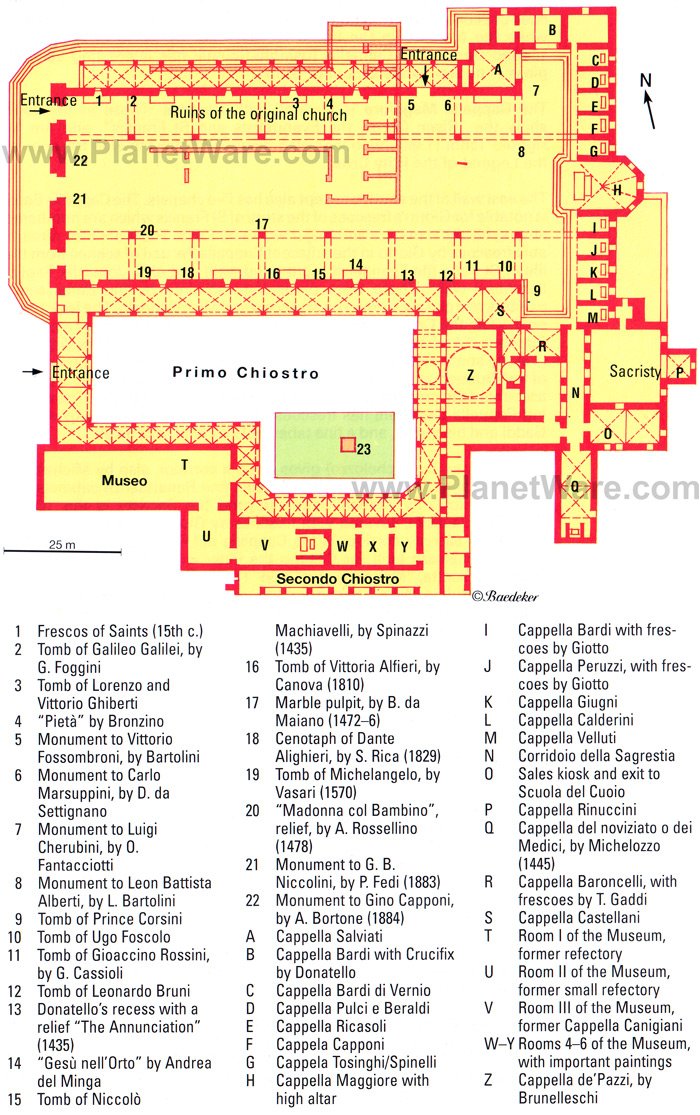
x. Ponte Vecchio
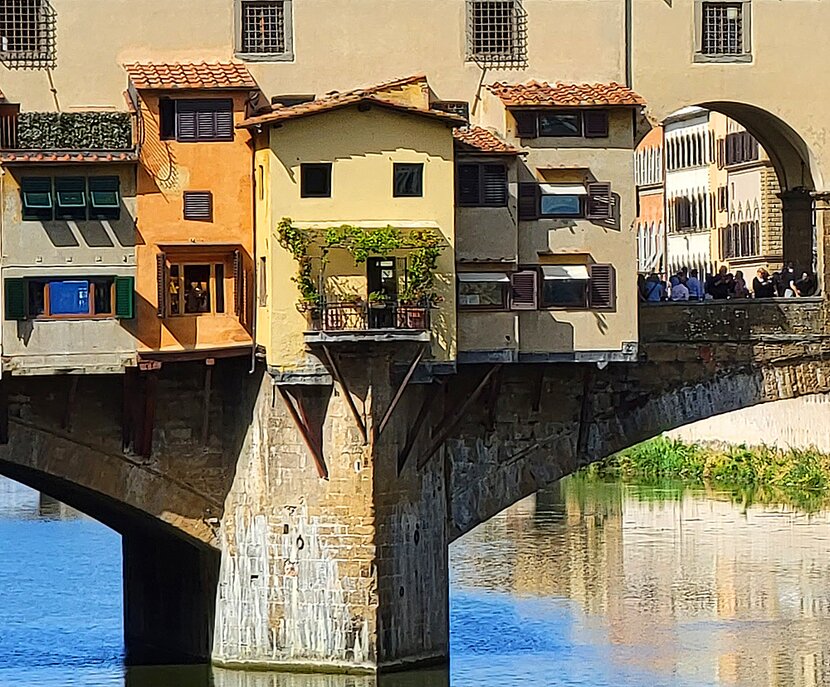
The Ponte Vecchio may well be the most widely recognized icon of Florence, and its svelte arches topped by a jumble of shops is almost certainly one of the city'south prettiest scenes. The bridge has traditionally been the home for the shops of Florence's talented goldsmiths, and a stroll across it even so shows a dazzling assortment of fine jewelry.
But almost tourists don't realize that some other set up of treasures hides to a higher place their heads. The purpose of the bridge, of course, was to link the two sides of the Arno, and the Medici needed to cross frequently between their offices in the Palazzo Vecchio and their apartments in the Pitti Palace. So they deputed the architect Vasari to build a passageway, officially called the Percorso del Principe (Passageway of the Prince), merely now more often known as the Corridoio Vasariano, Vasari Corridor.
You lot tin meet its line of evenly matched windows above the shops. It's not just a hallway; lining its walls is a priceless drove of portraits, mostly cocky-portraits, by artists that include Rembrandt, Leonardo da Vinci, Raphael, Michelangelo, and Velásquez.
xi. Palazzo Pitti (Pitti Palace)
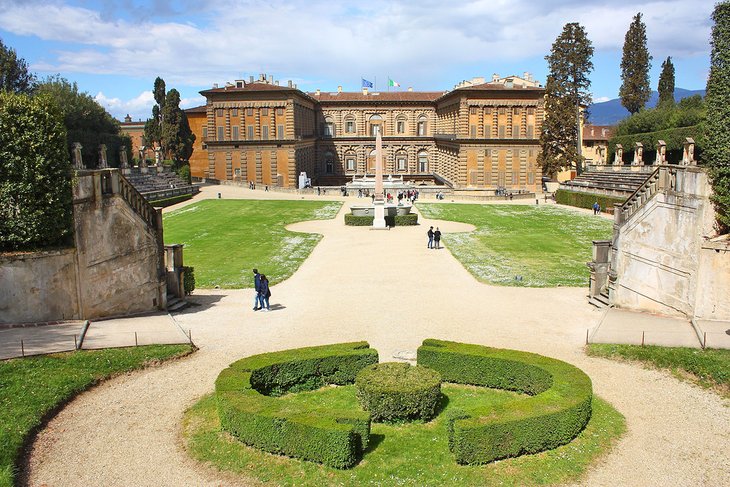
A day at the Pitti Palace complex (and you could spend a day seeing it all) gives yous a little gustatory modality of the many things Florence has to offer: an outstanding art gallery, a Medici palace, Florentine adroitness, museums, history, royal apartments, and one of Italy's premier gardens.
If a day isn't quite what you had in mind, at least tour the palace to come across the Royal Apartments and the sumptuous rooms, where you'll find paintings by Raphael, Titian, Rubens, Tintoretto, and other masters - a collection almost rivaling the Uffizi - hanging not in gallery style, just as decoration for rooms designed for entertaining and show.
- Read More: Exploring the Pitti Palace & Boboli Gardens in Florence: A Visitor's Guide
12. Santa Maria Novella
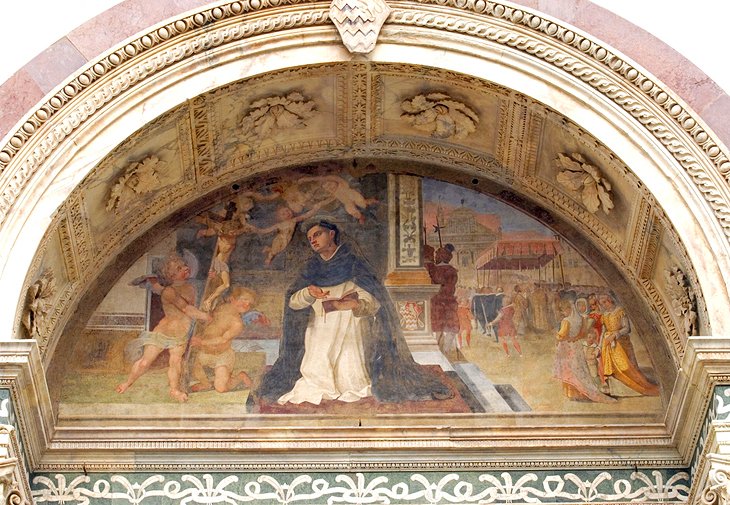
Although this Dominican church building has the familiar striped façade of inlaid marble worn by several other churches in Florence, hither it has been interpreted quite differently, tracing graceful curving designs, imitating windows, and highlighting rows of arches in the lower story.
The artistry continues inside, with some of the city's finest frescoes, past such masters every bit Masaccio, Giotto, Domenico Ghirlandaio, Lippi, Paolo Uccello. Every bit if that weren't enough, an unabridged chapel is lined with Andrea di Bonaiuto's frescoes, some of the greatest artworks of 14th-century Italy.
In add-on to the frescoes are a marble pulpit designed by Brunelleschi, his wooden crucifix, Vasari'due south Rosary Madonna, and a bronze by Lorenzo Ghiberti. Stop in at the convent'due south historic chemist's shop, where they sell herbal balms and floral lotions.
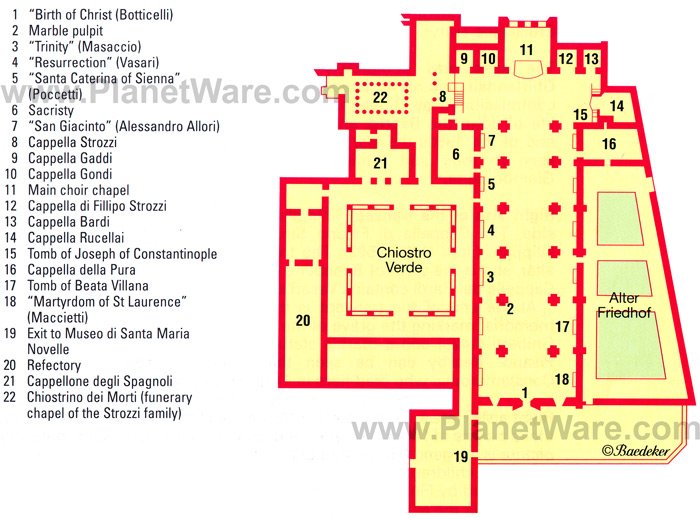
xiii. San Miniato al Monte
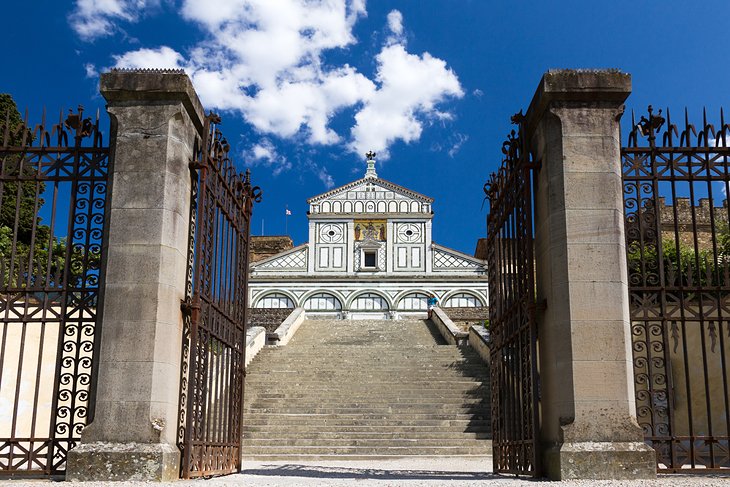
The sight of San Miniato al Monte's inlaid greenish-and-white marble façade is worth the short climb beyond the favorite viewpoint of Florence, Piazzale Michelangiolo (or yous can stay on the bus to ride here).
This was the kickoff time this dramatic effect was used in Florence, where it shortly became the most pop façade decoration. But different the subsequently facades, this one rises to a large gold mosaic. The portico result looks back to Classical Roman architecture, and the mosaics are distinctly Byzantine inspired, both influences that alloy into the new Tuscan Romanesque architectural mode.
Inside, at that place's a spacious open nave, with a mosaic floor and painted wooden ceiling, catastrophe at a magnificent Renaissance chapel nether a glazed bluish-and-white terracotta ceiling. More than Byzantine-style mosaics, a twelfth-century marble pulpit, and the decorated choir screen are all highlights,
Even more outstanding is the sacristy. Its walls are lined past the vibrant panels of Spinello Aretino's 14th-century masterpiece, Life of St. Benedict. It is among the about splendid rooms in Florence, and equal to those in whatever palace.
Address: Via delle Porte Sante, 34, Florence
14. Bargello Palace National Museum
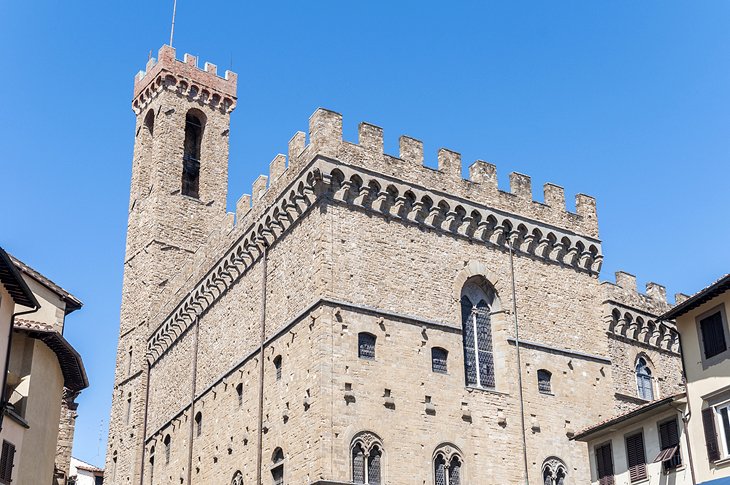
The four Michelangelo masterpieces alone are reason enough to put the Bargello Palace on your list of things to practice in Florence. Works by Donatello, the della Robbias, Cellini, Brunelleschi, Ghiberti, and 14th- to 16th-century Tuscan artists fill the palace, along with a room of ivory carvings and a collection of majolica.
An unabridged room is filled with enamels and gold piece of work, a Florentine specialty during the Renaissance. This emphasis on decorative arts and sculpture sets the Bargello apart from the rest of Florence'due south art museums.
Address: Via del Proconsolo 4, Florence
15. Stroll through Boboli Gardens
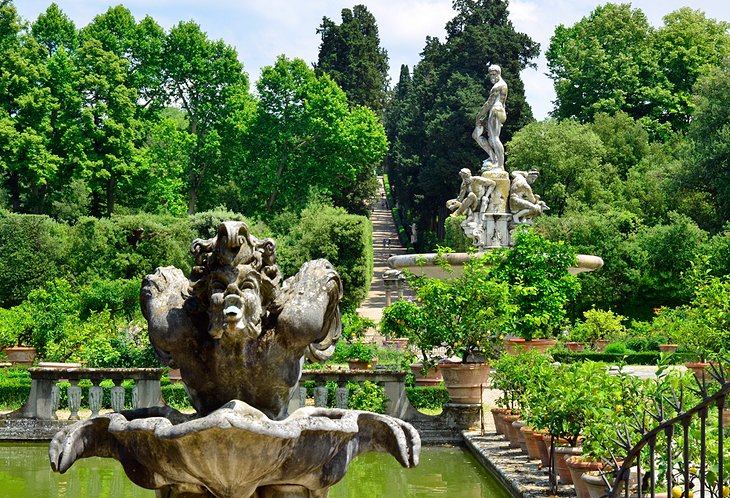
Behind the Pitti Palace, the Medicis' Boboli Gardens rise up the hillside in 111 acres of light-green terraces. Chiliad Duke Cosimo I spared no expense in their edifice, between 1550 and 1560, and the effect became the model for royal gardens all over Europe (including Versailles). Still beautifully manicured, the gardens climb to overlooks that reveal increasingly sweeping views over the metropolis.
Throughout are fountains, bronze, and a imitation cave complete with stalactites and stalagmites carved into the hillside, the Grotta del Buontalenti.
Other things to see include a maze, formal beds, fifty-fifty an amphitheater in the quarry hole left from removing stone to build the palace. At the highest point is the terrace of the Kaffeehaus, and at the top of the loma overlooking Boboli Gardens, Casino del Cavaliere houses a rich collection of porcelains endemic by ruling families, including the Medici and the Savoy.
- Read More: Exploring the Pitti Palace & Boboli Gardens in Florence: A Visitor's Guide
16. Explore the Oltrarno and Take a Pause in Piazza Santo Spirito
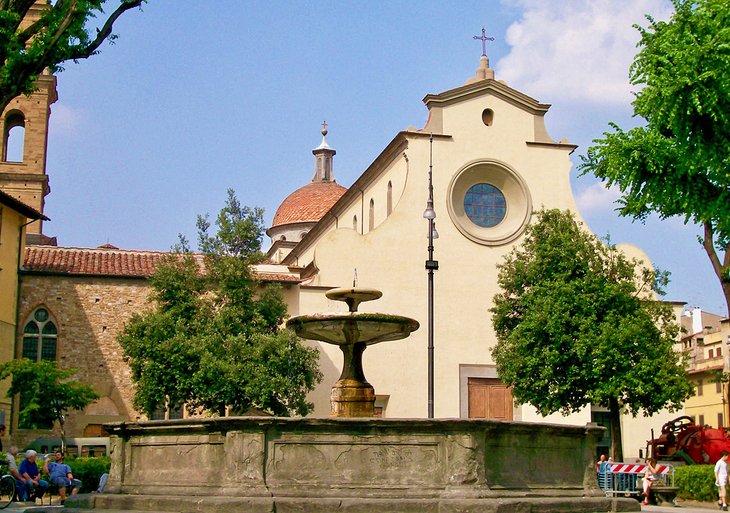
The Oltrarno is worth exploring for its atmospheric lanes and the workshops and studios of Florence's famous artists in wood, silver, and gold work; gilding; miniature mosaics; decorative papers; and leather bookbinding. You're certain to exist tempted by the works for sale in the small shops, and at that place is no better souvenir or gift than a beautifully bound journal or a gilded wooden box.
Make your way to Piazza Santo Spirito, a lively foursquare that'south more intimate than the grander, busier ones across the river. Find an outdoor table at a café or eating place and watch shoppers at the morning market or children playing ball later school.
Although it's not i of the best-known churches in Florence, the Basilica of Santo Spirito is one of the purest Renaissance churches and is filled with notable paintings and sculpture, peculiarly in the transept chapels
17. Palazzo Medici-Riccardi
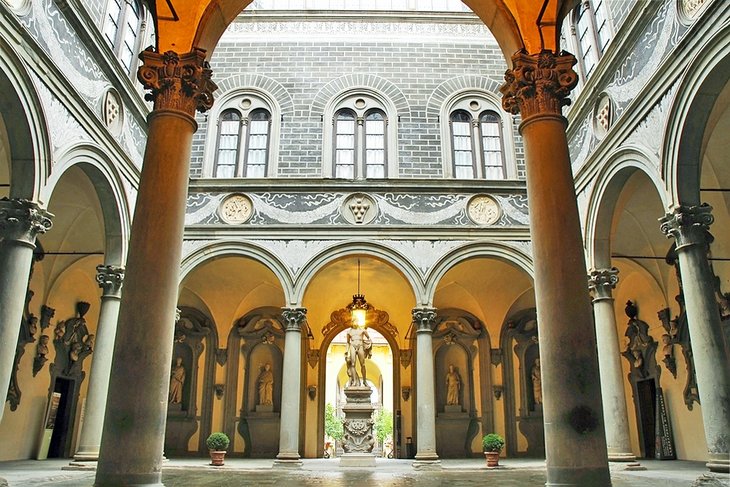
More restrained in its furnishing and décor than the showy palaces of afterwards members of the Medici family, Palazzo Medici-Riccardi is more in line with the earlier dukes, who governed a more democratic order. Completed in 1464, information technology was the home of the Medicis for almost a century until Cosimo I moved to the Palazzo Vecchio.
A staircase leads from the courtyard to the Palace Chapel, busy with well-preserved frescoes by Benozzo Gozzoli that give a skilful sense of court life in fifteenthursday-century Florence.
Although the Riccardi family unit, which owned the business firm afterward the Medicis, made alterations, the Medici Museum on the ground floor retains the original Medici interior. Here, also, is one of Filippo Lippi's near important works, Madonna and Child, painted in1442.
Address: Via Cavour 1 & 3, Florence
Official site: world wide web.palazzo-medici.information technology
xviii. Mercato Centrale: Florence's Food Market
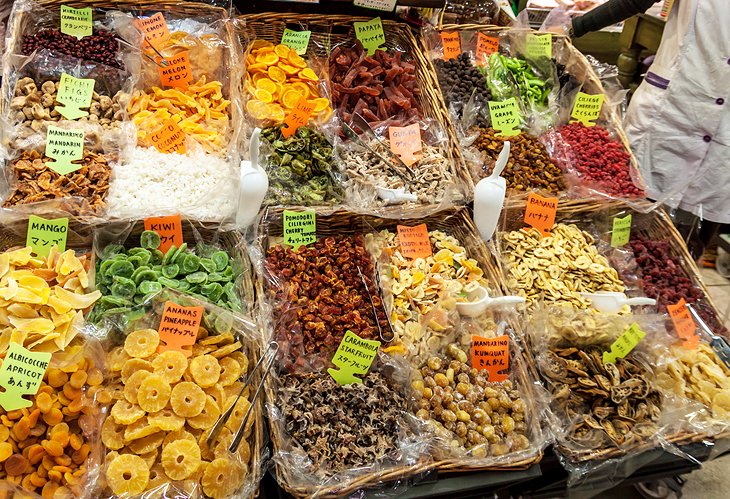
If you lot have begun to worry that Florence is just one behemothic open-air museum, it's time to come across some Florentines as they become most their daily routines. At that place's no better identify to find them than in the enormous food market, Mercato Centrale.
To get hither, you lot may have to run a gauntlet of street stalls selling everything from cheap plastics to "accurate Italian crafts" that are mass-produced, mostly in Asia. Just once inside and immersed in the fragrance of fresh herbs, flowers, and garden produce, yous'll rub elbows with women shopping for ingredients for today's dinner.
Don't overlook this as a source of welcome gifts to take abode, including fine Tuscan olive oils, olives, candied fruits, and luscious nougat. On the upper floor, you'll detect food courts, a good place to visit for a quick lunch.
Address: Piazza del Mercato, Florence
19. Bardini Museum and Gardens
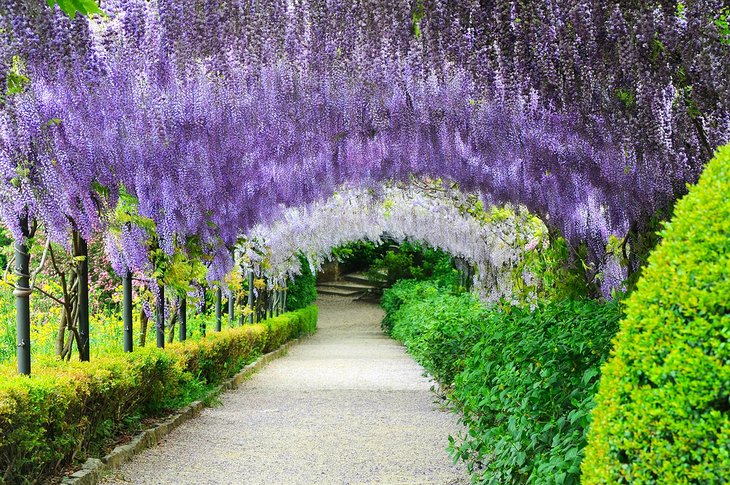
In the tardily 19th century, artist and collector Stefano Bardini bought a group of buildings on a hillside in the Oltrarno, overlooking Florence. From these, which included a chapel and a former palazzo dating from the 14th century, he created a setting for his collections of art and priceless antiquities.
To create this museum, he used architectural features salvaged from demolished medieval and Renaissance buildings. Monumental fireplaces, doors and windows, columns, carved stonework, entire staircases, paneling, carved Venetian woodwork, even unabridged ceilings accept been retrofitted into a highly eccentric home for his equally eccentric collections.
Simply the resulting palazzo and its magnificent artworks are not the only attraction for tourists. After completing his museum, Bardini bought a neighboring garden overlooking the river and transformed it into an outdoor gallery to display some of his sculpture collections.
The Bardini Gardens overlook Florence, a lovely place to get away from the crowds and rest your optics amidst the greenery and flowers. The best fourth dimension is in Apr, when brilliant purple wisteria covers the pergola and fills the air with fragrance. A long staircase, mosaic fountains, an English language garden, and a terrace with a café brand it a pleasant place to relax. Archway to the garden is separate from the museum.
Bardini Gardens
- Costa San Giorgio 2, Florence
Bardini Museum
- Via dei Renai 37, Florence
xx. Brancacci Chapel
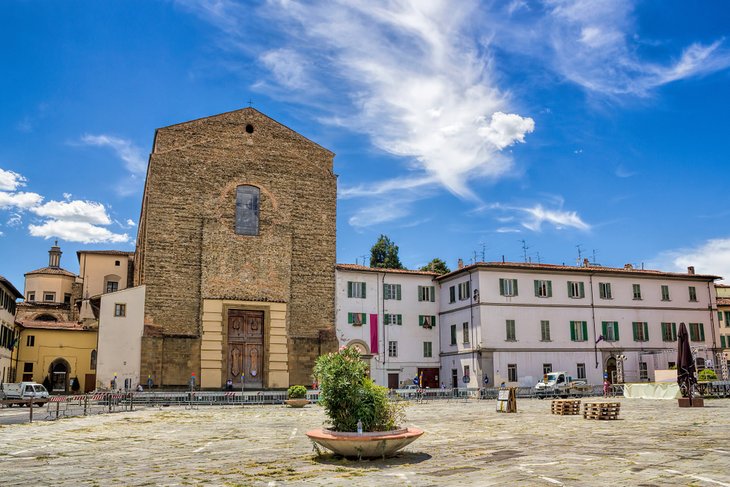
You lot would never guess by looking at the patently façade of Santa Maria del Carmine church that within holds one of the great masterpieces of the 15thursday century. Frescoes on the walls and ceilings of the chapel depict the life of St. Peter and Old Attestation scenes past Masaccio and Masolino, who were well-known artists in the early 1400s, friends of Brunelleschi and Donatello.
The works, especially those of Masaccio, are remarkable for their vivid colour and vitality, demonstrating some of the beginning use of perspective, and showing facial expressions that requite life and energy to his figures.
Masaccio is considered the first swell Italian painter of the Quattrocento period (15thursday century) of the Italian Renaissance and the founder of the Early Italian Renaissance. The chapel was left unfinished by the 2 painters and was completed afterward in the 1400s by Filippino Lippi. Although the chapel is an of import landmark, and a magnificent work of art, it is one of the least known treasures of Florence.
Address: Piazza del Carmine fourteen, Florence
21. Museo Galileo
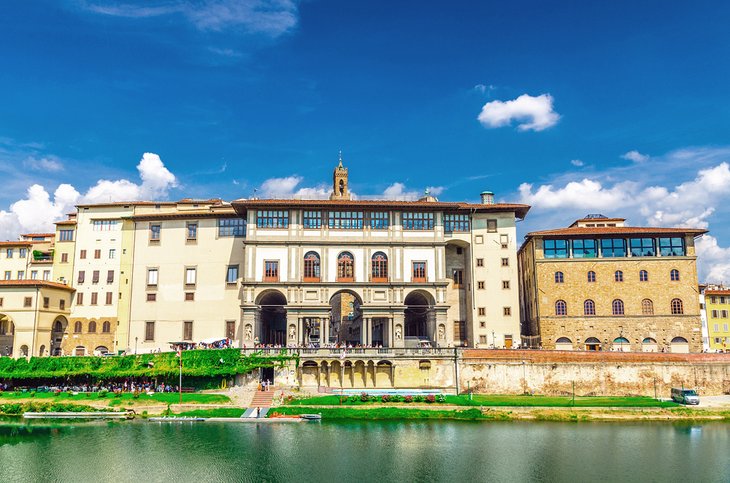
With the abundance of Renaissance painting, sculpture, architecture, and other masterpieces in Florence, it's easy to forget that the Renaissance was nigh more than fine art. Scientific discipline was a major concern of the Humanists as they broke away from the confines of religion to explore their universe. And they saw fine art and scientific discipline equally connected and inseparable.
The Museo Galileo proves this, with tools of astronomy, navigation, surveying, and exploring that are priceless works of fine art. You'll see Galileo's ain instruments, and the work of some of Florence'due south foremost artists in metal, wood, gilded, and other arts in the collections of compasses, tools, and magnificent world globes.
Accost: Piazza dei Giudici ane, Florence
Official site: https://www.museogalileo.it/en/
22. Store for Leather at Piazza Santa Croce
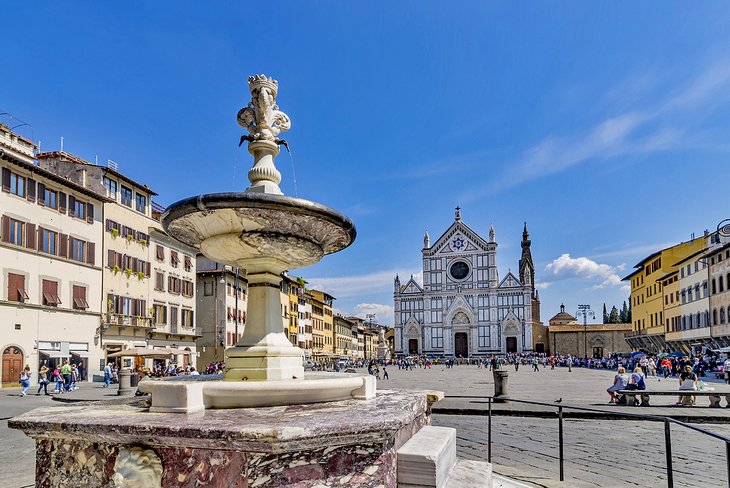
Fine leatherwork has been a tradition in Florence at least since Renaissance times, when leatherworkers had their workshops around Santa Croce, close to the tanneries along the river. That neighborhood is still the all-time place to shop for Florentine leather goods. To find the all-time quality, and at off-white prices, shop at the leatherwork school or at an artisan's studio shop; some of the other shops, similar the street marketplace vendors, sell imported and fake leather goods.
Inside the cloister of Santa Croce, the Scuola di Cuoio leatherworking schoolhouse produces fine handmade leather goods, and you tin watch the students manner wallets, boxes, handbags, and leather jackets. At that place you'll find Francesca Gori'south 1-off handbags in rare and exotic leathers, designed especially for the school. You lot'll also detect luggage, jump books, belts, jewelry boxes, and leather wear.
Likewise on Piazza Santa Croce is Misuri, in a onetime palazzo covered in frescoes, with equally fine traditional craftsmanship and designs.
Accost: Piazza Santa Croce, Florence
Official site: world wide web.scuoladelcuoio.com
Where to Stay in Florence for Sightseeing
From the UNESCO-acclaimed complex of the cathedral, baptistery, and Giotto'south Campanile to the museums and gardens of the Pitti Palace, on the contrary side of the Arno River, Florence'southward main tourist attractions lie inside easy walking distance. And surprisingly, at that place are enough of places to stay in the centro storico (celebrated eye). Here are some highly rated hotels in Florence:
Luxury Hotels:
- Side by side to the cathedral and some of the best shopping streets, Brunelleschi Hotel has recently renovated invitee rooms in a celebrated building with a medieval belfry. Superb service, views of the Duomo, and complimentary breakfast add together to its appeal.
- Close to attractions but just across the crowded streets of the main tourist expanse, Iv Seasons Hotel Firenze rooms have views over Florence and the gardens.
- Famed for its infrequent invitee services, Portrait Firenze is on the Arno River overlooking Ponte Vecchio, a block from the Uffizi Gallery.
Mid-Range Hotels:
- Family unit-run Hotel Davanzati , in the historic heart near Piazza della Signoria and the cathedral, offers costless breakfast and a relaxing patio but no elevator.
- In the historic center, just a curt walk from the busiest streets, Hotel Orto De Medici has individually decorated, soundproof rooms, some with private balconies.
- The highly popular Hotel David , on the Oltrano side of the Arno on the way to Piazzale Michelangelo, includes costless breakfast and is especially handy for those driving to Florence, offering free parking.
Upkeep Hotels:
- In a historic home halfway between Santa Croce and Piazza della Signoria, Hotel Santa Croce has costless breakfasts that include cappuccino; in that location's no elevator, simply the staff helps with luggage.
- Gratis buffet breakfast and Wi-Fi, a brusque walk from Santa Maria Novella rail station and the major attractions, make Hotel Fiorita a adept selection for budget travelers.
- In a tranquility residential neighborhood a few streets from Santa Croce, Hotel Orcagna is an inviting upkeep option, with bonny rooms (some with balconies) and free breakfast.
Tips and Tours: How to Make the Most of Your Visit to Florence
- Getting Around: You lot can save both fourth dimension and energy with a Florence City Hop-on Hop-off Bout that stops at eighteen of the pinnacle attractions in the city, including the must-see view from loftier above the metropolis at Piazzale Michelangiolo. You can choose a one-, 2-, or 3-day pass for unlimited rides and 360-degree views from the open up-air bus.
- Tuscany Twenty-four hour period Trip: Rolling hills bathed in gold calorie-free and quaint hilltop villages surround the city of Florence, and the Tuscany in One Mean solar day Sightseeing Tour is a cracking mode to see the highlights. An experienced guide will you in a luxury air-conditioned coach to Siena, San Gimignano, and Pisa. The tour includes a three-course luncheon, archway fees to Siena Cathedral, and a detailed map of all the destinations.
- Cinque Terre Semi-Private Day Trip: If you want to add together another of Italy'southward famous attractions to your itinerary, the Cinque Terre Semi-Individual Day Trip from Florence is an first-class option. See the colorful, cliff-hugging villages of this stunning stretch of declension and cruise across the h2o between Manarola and Vernazza. This full-24-hour interval tour allows time for you to explore the villages and includes archway fees to the coastal walking path, round-trip transportation in an air-conditioned minivan, the boat ride, and a snack. To ensure personalized service, the tour is only for small groups, with a maximum of eight people.
- Cinque Terre Twenty-four hour period Trip with Optional Hiking: For incomparable views and one of the top experiences in Italy, hike a 5.5-kilometer stretch of the famed Cinque Terre walking path between towns on a Cinque Terre Day Trip from Florence with Optional Hiking . The bout includes fourth dimension for a swim, and transport from Florence on an air-conditioned coach.
More Things to See and Do
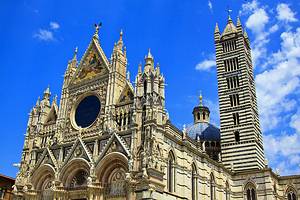 Places to Visit near Florence: Several of the all-time places to visit in Italian republic are close to the urban center. The beautiful medieval city of Siena to the southward is crowned by one of Italy's most magnificent - and largest - cathedrals, filled with more art masterpieces than some major museums. This and a string of Medici villas are all easy day trips from Florence.
Places to Visit near Florence: Several of the all-time places to visit in Italian republic are close to the urban center. The beautiful medieval city of Siena to the southward is crowned by one of Italy's most magnificent - and largest - cathedrals, filled with more art masterpieces than some major museums. This and a string of Medici villas are all easy day trips from Florence.
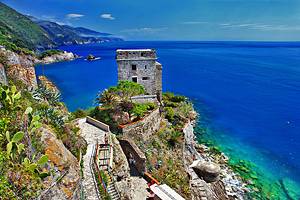 Where to Get from Florence: Pisa's famous Leaning Tower is one of the top tourist attractions in Italy, and only the commencement of beautiful Renaissance monuments and artworks to run into in that location. Less well-known - and less crowded- is the mannerly, small city of Lucca, surrounded by walls so thick, there'southward a popular promenade along their tops. Beyond, the Tuscan declension leads into Liguria, with the v villages and magnificent scenery of the Cinque Terre.
Where to Get from Florence: Pisa's famous Leaning Tower is one of the top tourist attractions in Italy, and only the commencement of beautiful Renaissance monuments and artworks to run into in that location. Less well-known - and less crowded- is the mannerly, small city of Lucca, surrounded by walls so thick, there'southward a popular promenade along their tops. Beyond, the Tuscan declension leads into Liguria, with the v villages and magnificent scenery of the Cinque Terre.
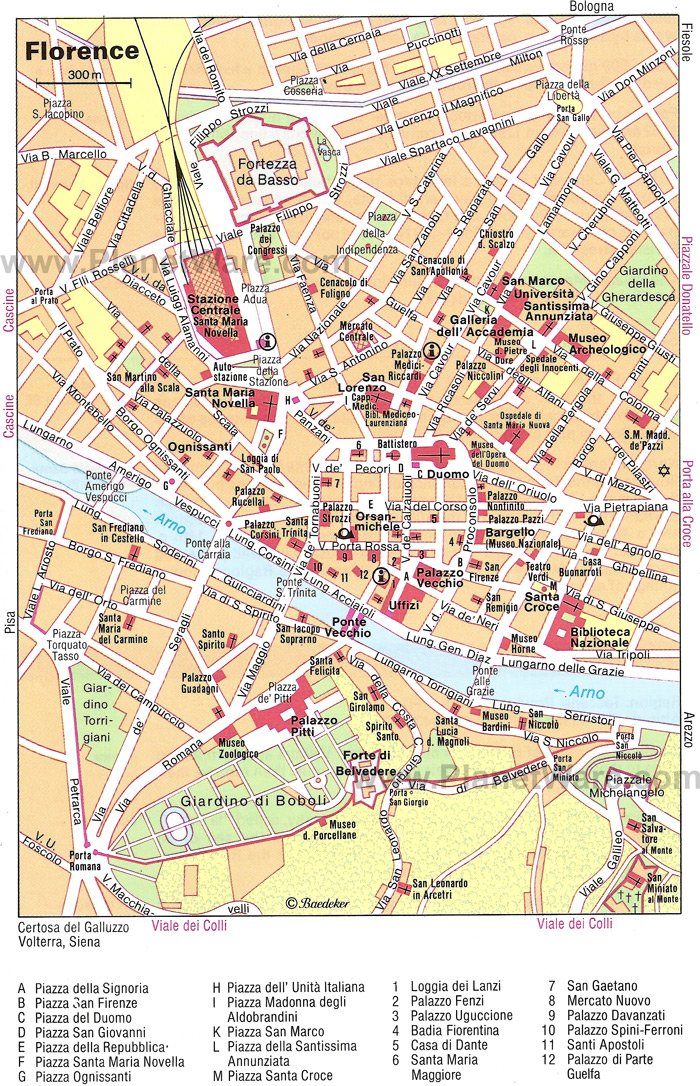 Florence Map - Attractions (Historical)
Florence Map - Attractions (Historical)
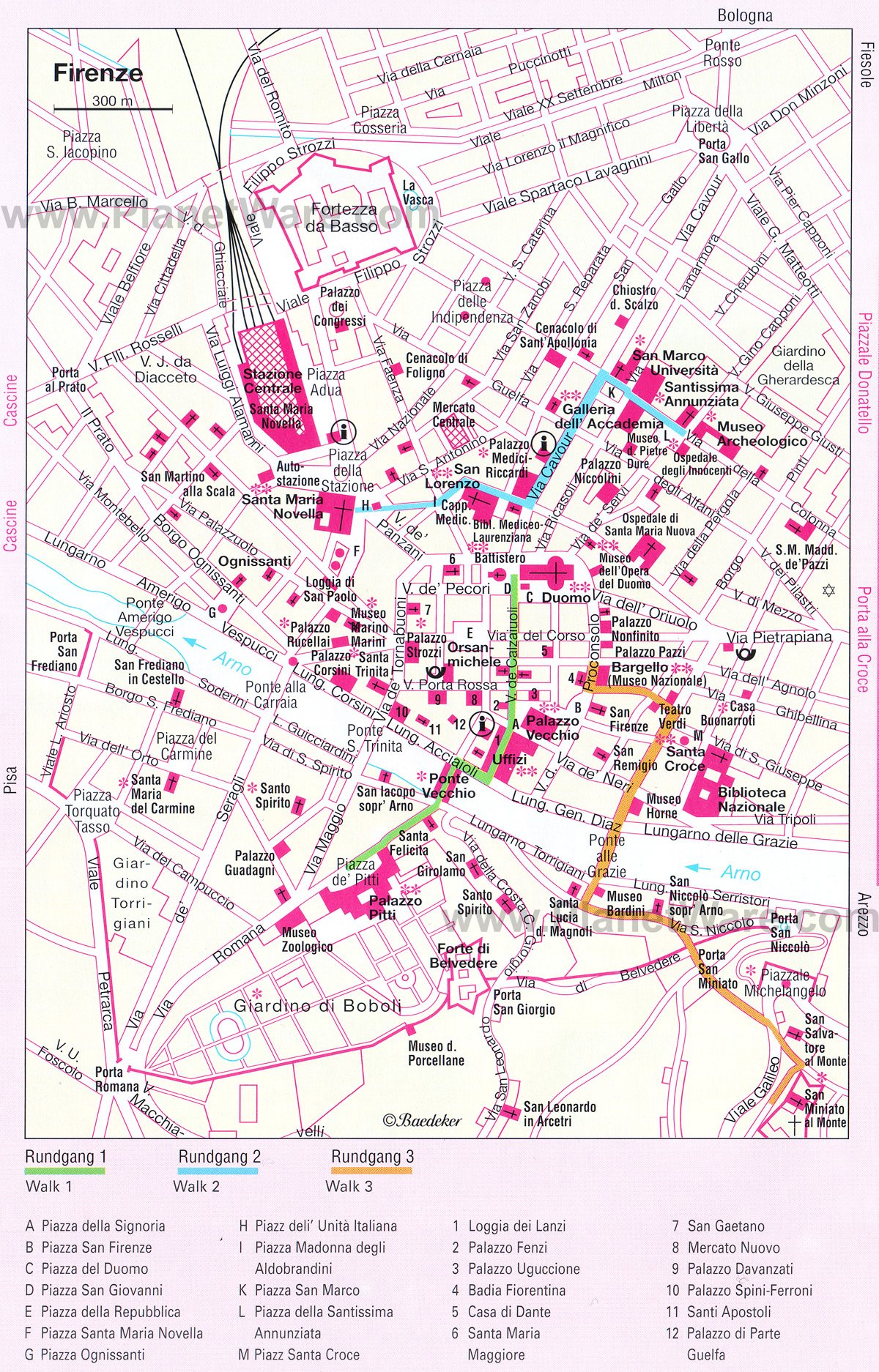 Florence Walking Tours Map (Historical)
Florence Walking Tours Map (Historical)
Source: https://www.planetware.com/tourist-attractions-/florence-i-to-f.htm
0 Response to "This Famous Piazza Is Known for Its Ristorante Arte and Evening Activities"
Postar um comentário